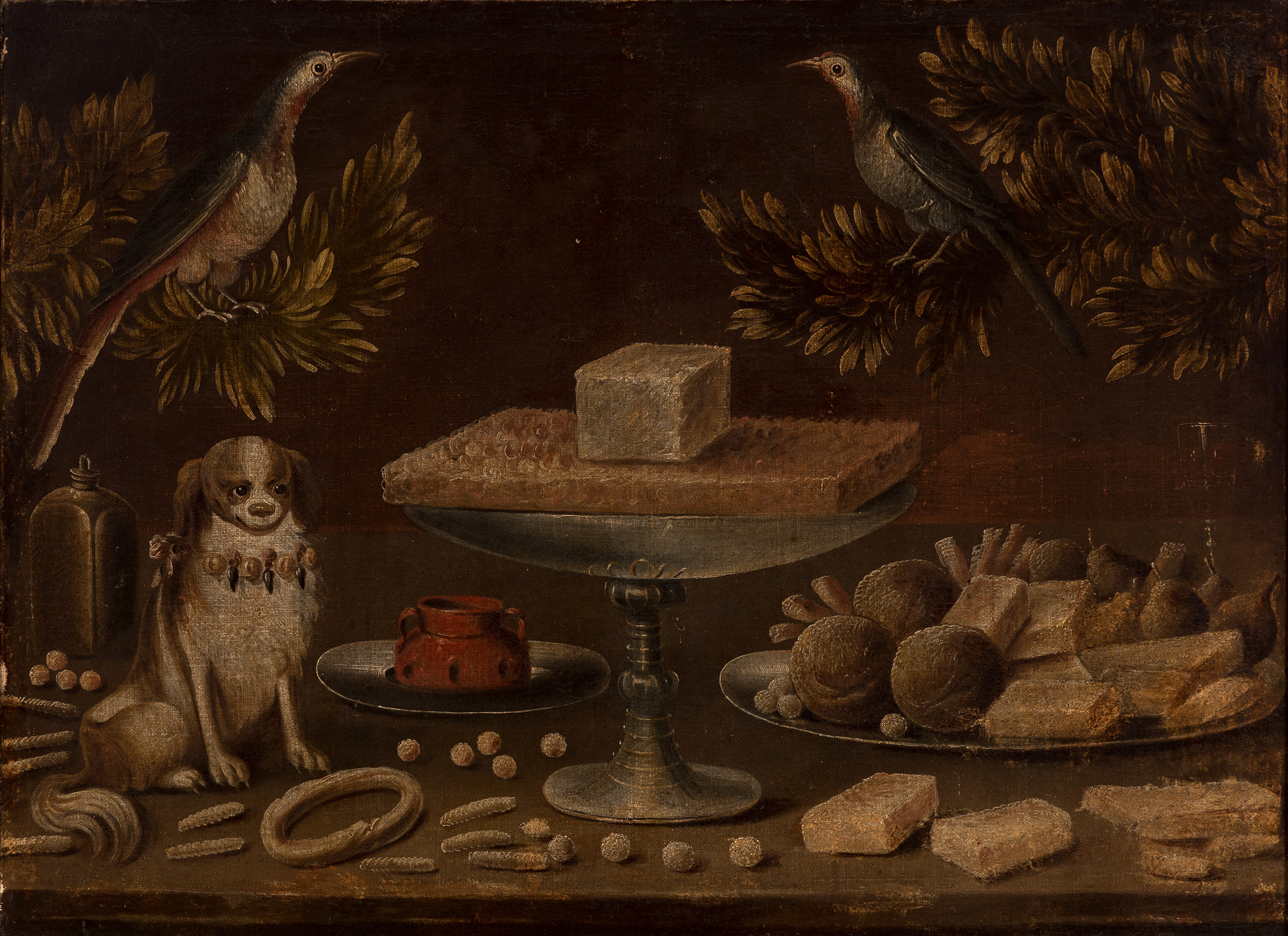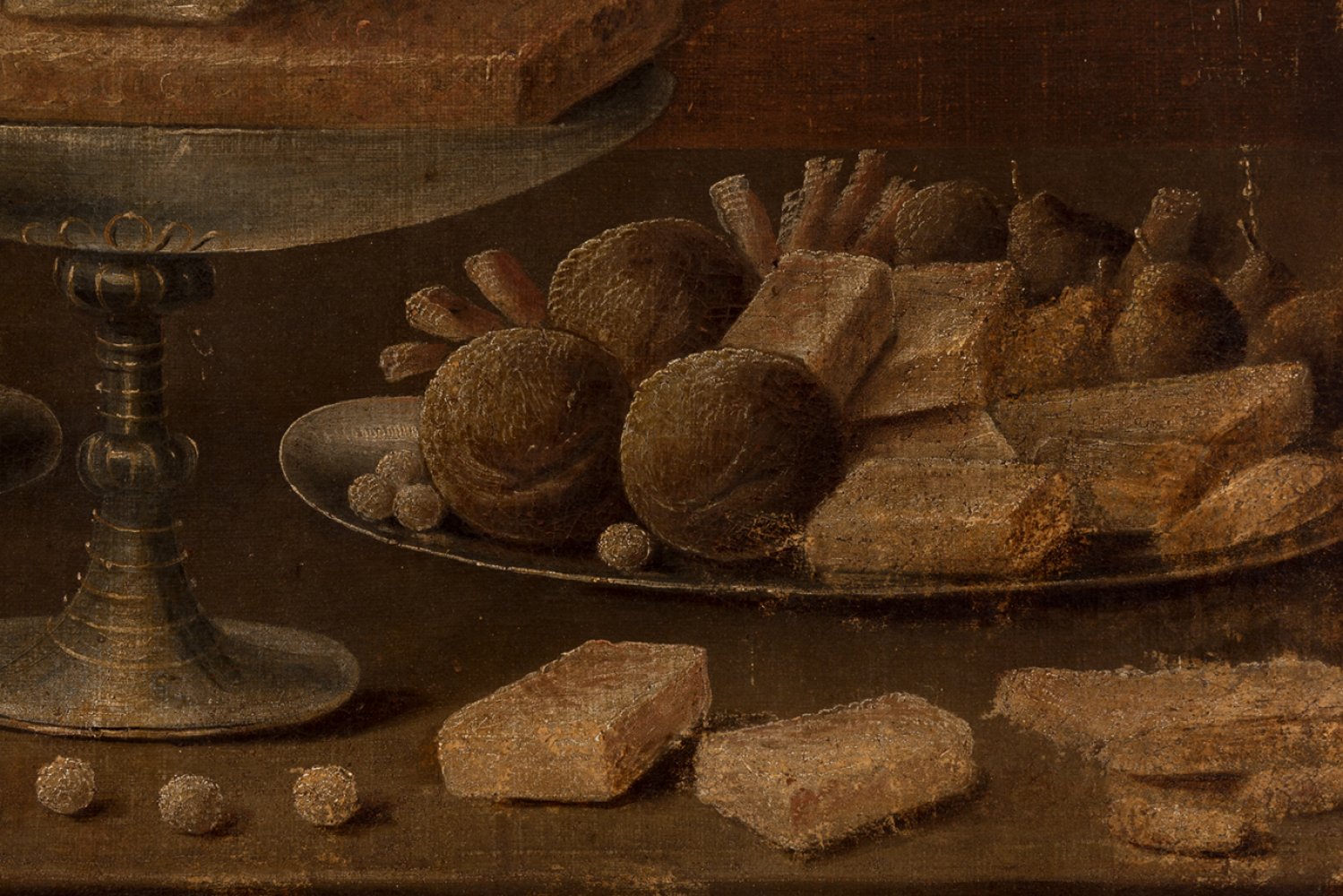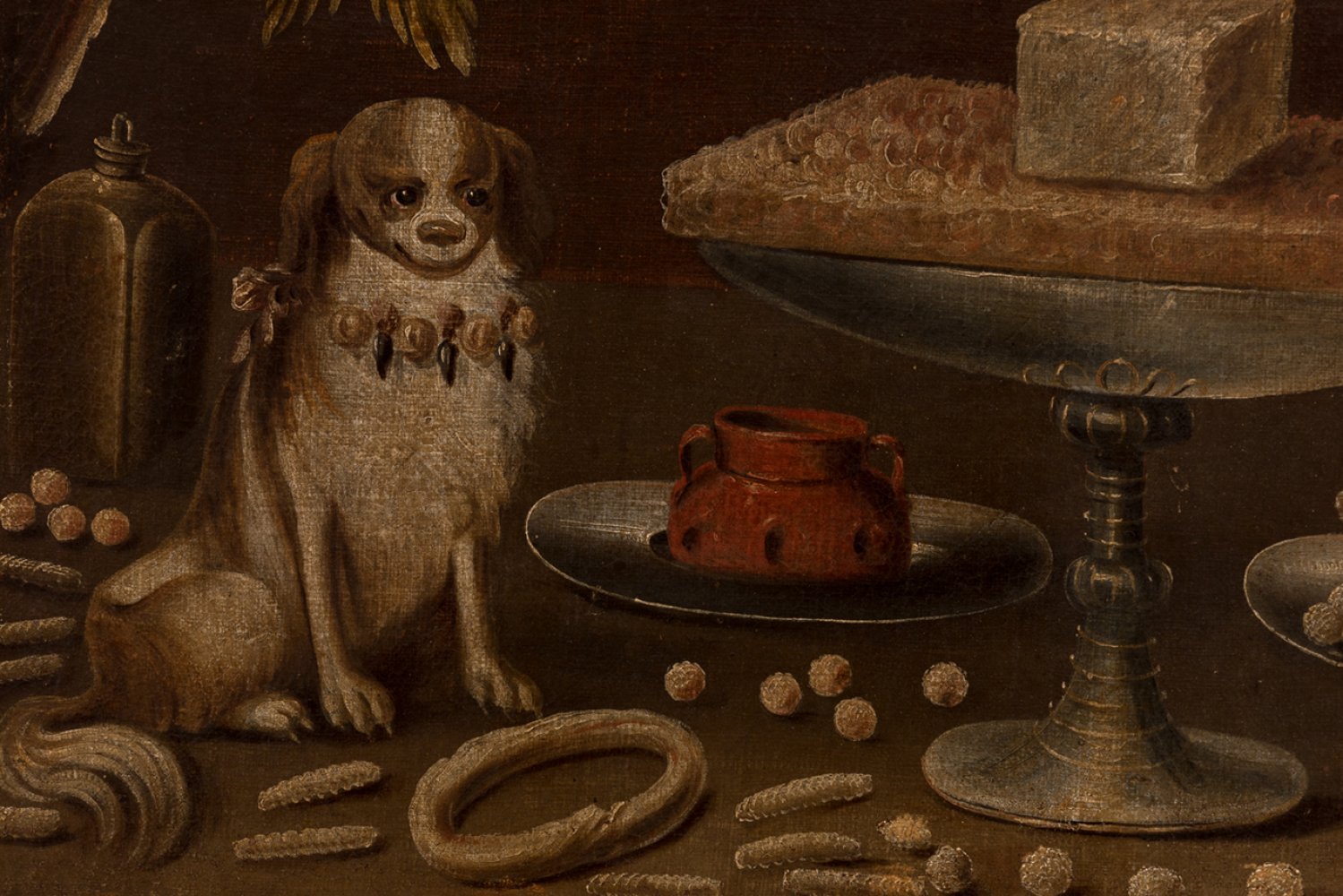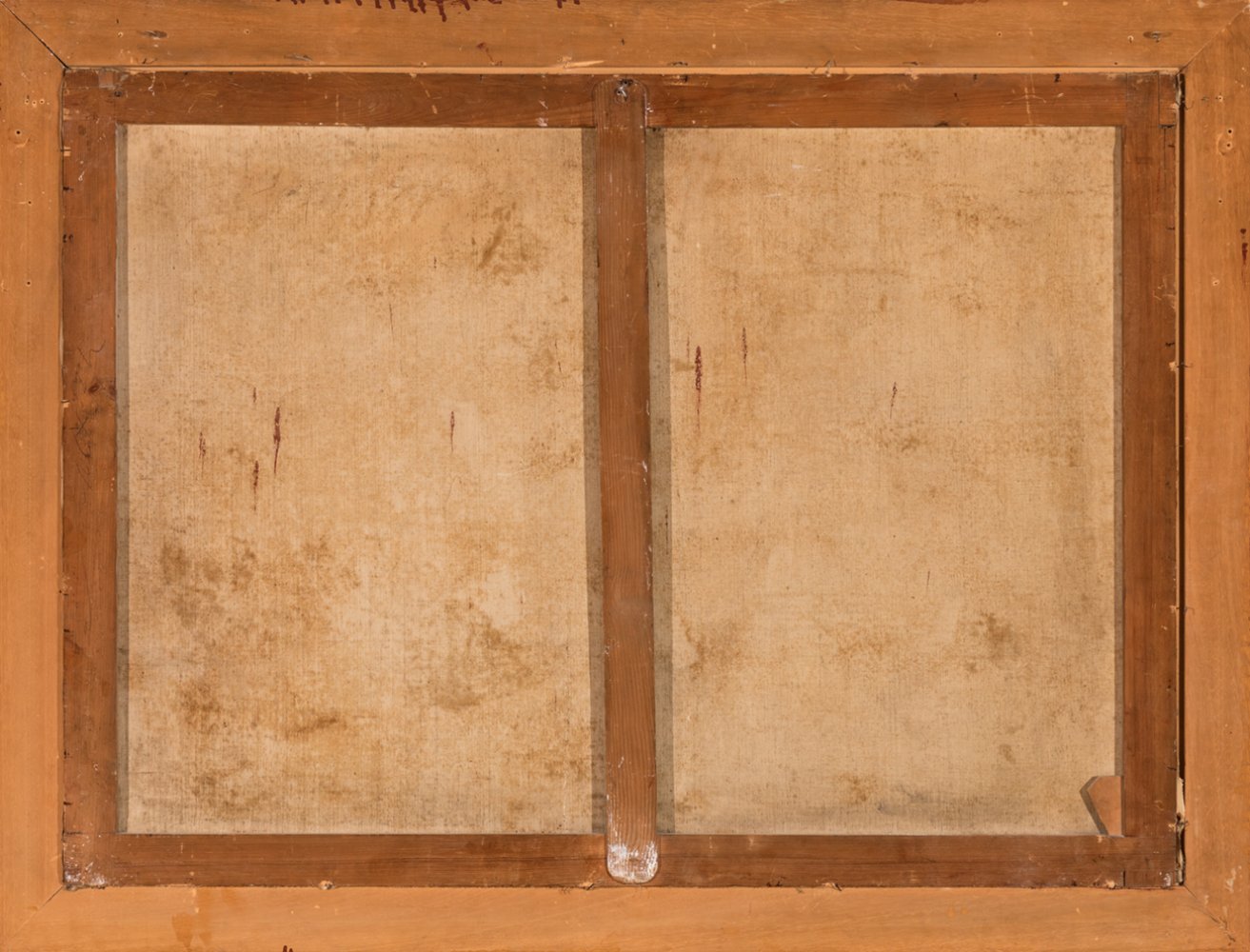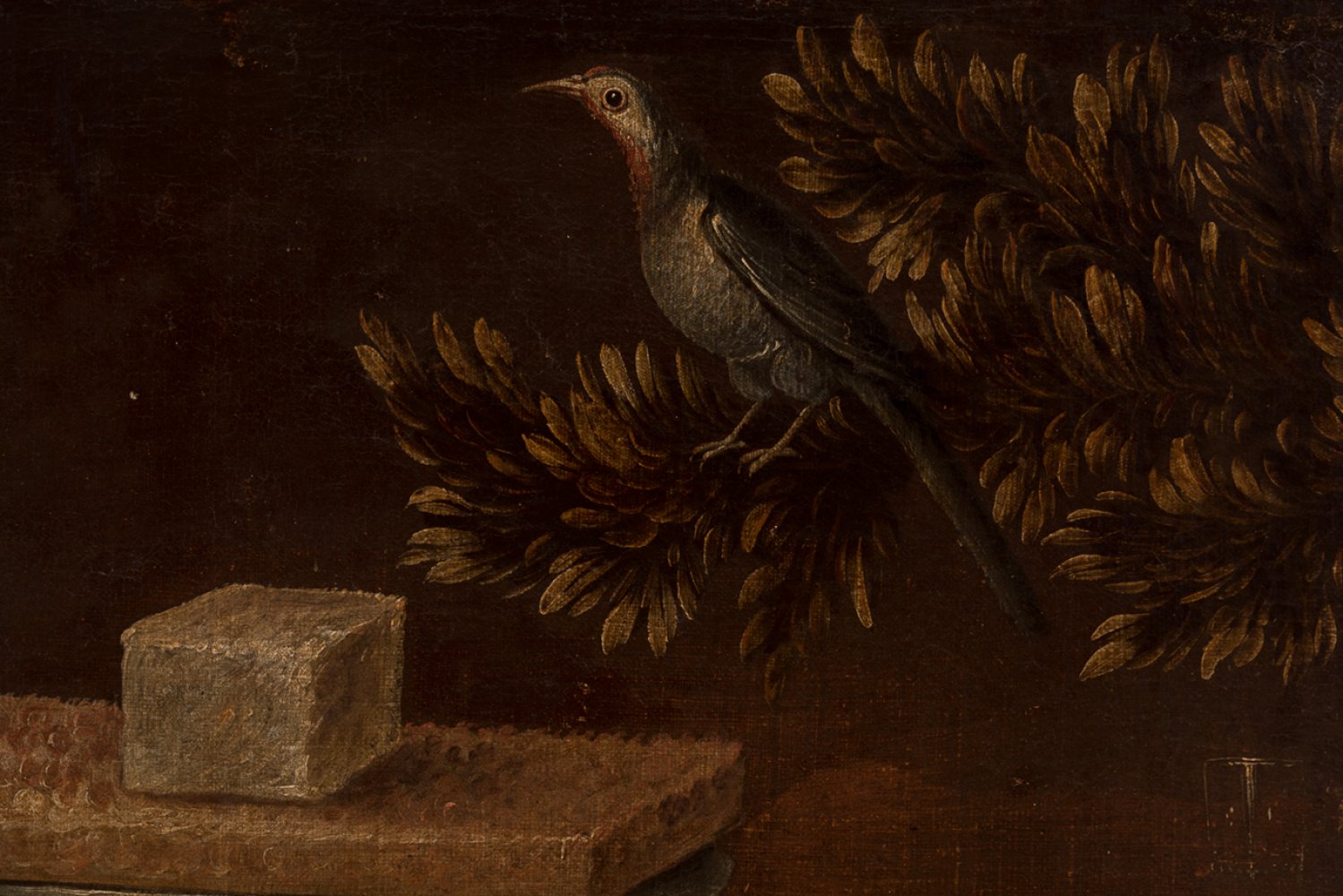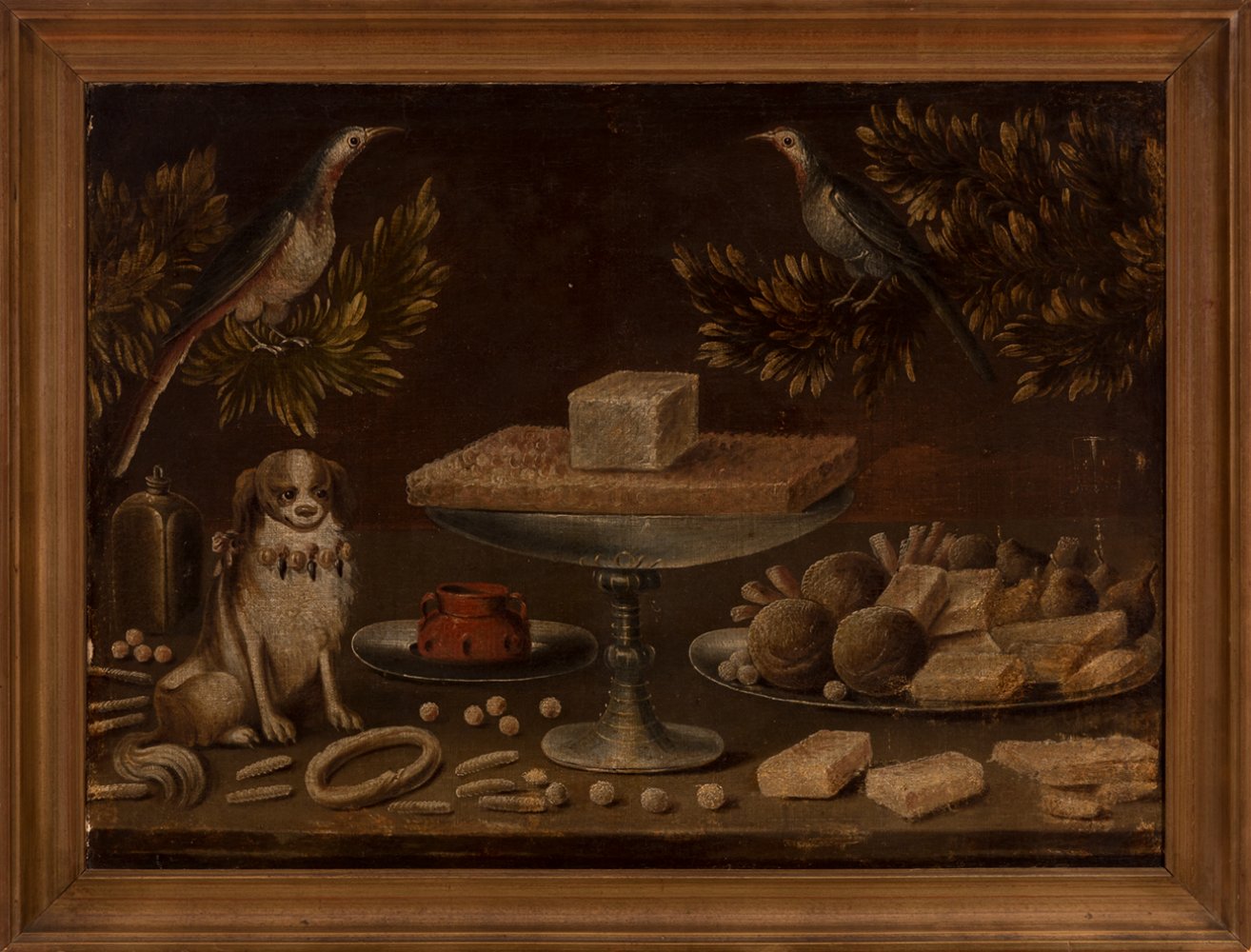6
Workshop of BLAS DE LEDESMA (Documented in Granada between 1602 and 1614); first half of the 17th
"Still life".
Oil on canvas. Re-coloured.
It presents repainting and damages.
Measurements: 77 x 105,5 cm; 91 x 121,5 cm (frame).
Baroque still life of symmetrical composition, which stands out for the abundance of food and animals that are presented on the table. The elements are arranged at various heights, creating a complex yet highly visual image. The still life in Spain was one of the most characteristic genres and, due to its special characteristics, is clearly differentiated from the same subject in workshops in the rest of Europe. The term appeared at the end of the 16th century, and stands out in this school for its austerity, in clear contrast to Flemish sumptuousness, although with a series of influences from the latter and the Italian school. Sánchez Cotán's works were so successful that his style had numerous followers (Juan de Espinosa, Antonio Ponce, Juan van der Hamen y León, etc.). In this context, the Sevillian school contributed its own particularities, thanks above all to Velázquez and Zurbarán.
Blas de Ledesma was one of the first Spanish artists to cultivate the still life. Although he is a very poorly documented artist, of whom only one signed work survives, we do know that in 1602 he was in Granada, working with Pedro de Raxis on the paintings for the dome crowning the imperial staircase of the Monastery of Santa Cruz la Real. In fact, Pacheco praises him as a mural painter in his "Arte de la Pintura", and cites him, together with Pedro de Raxis and Antonio Mohedano, as a follower of Giulio Aquili and Alejandro Mayner, who introduced the grotesques into the Alhambra Palace. In 1614 he is again documented in Granada, drawing a plaster vault for the Sala de los Mocárabes in the Alhambra. He is also mentioned as working in the cathedral with Miguel Cano. We know nothing more about his life until January 1616, when the Corpus Christi Brotherhood, to which he belonged, celebrated a Mass for his soul, from which we can deduce that he must have died at the end of 1615 or early the following year. We also know, however, that he was recognised as a painter of fruit bowls, as attested by Pedro Soto de Rojas, who dedicated verses to him comparing him to Zeuxis in his "Paraíso cerrado para muchos, jardines abiertos para pocos" ("Paradise closed to many, gardens open to few") of 1652. To date we know of only one work signed by him that can be safely attributed to him, the "Still Life of Cherries" in the High Museum of Art in Atlanta (USA). It is a still life which is evidence of the knowledge of Juan Sánchez Cotán (present in Granada from 1604), characterised by a rigorously geometric composition, with the objects on a table in front of a black background, meticulously worked in great detail.
"Still life".
Oil on canvas. Re-coloured.
It presents repainting and damages.
Measurements: 77 x 105,5 cm; 91 x 121,5 cm (frame).
Baroque still life of symmetrical composition, which stands out for the abundance of food and animals that are presented on the table. The elements are arranged at various heights, creating a complex yet highly visual image. The still life in Spain was one of the most characteristic genres and, due to its special characteristics, is clearly differentiated from the same subject in workshops in the rest of Europe. The term appeared at the end of the 16th century, and stands out in this school for its austerity, in clear contrast to Flemish sumptuousness, although with a series of influences from the latter and the Italian school. Sánchez Cotán's works were so successful that his style had numerous followers (Juan de Espinosa, Antonio Ponce, Juan van der Hamen y León, etc.). In this context, the Sevillian school contributed its own particularities, thanks above all to Velázquez and Zurbarán.
Blas de Ledesma was one of the first Spanish artists to cultivate the still life. Although he is a very poorly documented artist, of whom only one signed work survives, we do know that in 1602 he was in Granada, working with Pedro de Raxis on the paintings for the dome crowning the imperial staircase of the Monastery of Santa Cruz la Real. In fact, Pacheco praises him as a mural painter in his "Arte de la Pintura", and cites him, together with Pedro de Raxis and Antonio Mohedano, as a follower of Giulio Aquili and Alejandro Mayner, who introduced the grotesques into the Alhambra Palace. In 1614 he is again documented in Granada, drawing a plaster vault for the Sala de los Mocárabes in the Alhambra. He is also mentioned as working in the cathedral with Miguel Cano. We know nothing more about his life until January 1616, when the Corpus Christi Brotherhood, to which he belonged, celebrated a Mass for his soul, from which we can deduce that he must have died at the end of 1615 or early the following year. We also know, however, that he was recognised as a painter of fruit bowls, as attested by Pedro Soto de Rojas, who dedicated verses to him comparing him to Zeuxis in his "Paraíso cerrado para muchos, jardines abiertos para pocos" ("Paradise closed to many, gardens open to few") of 1652. To date we know of only one work signed by him that can be safely attributed to him, the "Still Life of Cherries" in the High Museum of Art in Atlanta (USA). It is a still life which is evidence of the knowledge of Juan Sánchez Cotán (present in Granada from 1604), characterised by a rigorously geometric composition, with the objects on a table in front of a black background, meticulously worked in great detail.
9th November - Old Masters
Sale Date(s)
Venue Address
General delivery information available from the auctioneer
Setdart offers Worldwide shipping
PICK UP IN ROOM: You can come and pick up your lots in our offices (Barcelona, Madrid or Valencia). At the moment of the withdrawal, you will be able to accept the current conditions of the lot by means of a document that you will sign.
YOU CAN SEND ANOTHER PERSON TO PICK UP: This person must present a signed authorization that you can find in our web page by accessing from BUY AT SETDART- LOGISTICS-DOWNLOAD AUTHORIZATION DOCUMENT. You can also send an e-mail with the requested data in AUTHORIZATION DOCUMENT to admin@setdart.com
Important Information
25% buyer´s premium
OR
21% buyer´s premium at www.setdart.com
Terms & Conditions
The maximum period to pay the lots is 7 working days. You can pay either via bank transfer or with credit card through our platform www.setdart.com (we only accept VISA or Mastercard).
BUYER´S PREMIUM: 22% Hammer price + 21% VAT from the buyer´s premium
If your piece has more than 100 years, our Ministry of Culture requires an export certificate in order for the piece to leave the country. Note that if the piece goes inside the EU, there is no cost for the export certificate. If the piece goes outside the EU, there is a cost for the export certificate. You can find more information in our Ministry of Culture website: https://www.culturaydeporte.gob.es/en/cultura/patrimonio/exportacionimportacion/exportacion/tasas.html
INQUIRIES: admin@setdart.com
Setdart guides you through the entire process, from the time of award to the day you receive your lot. Our logistics team will be happy to manage your transport, and will advise you on the best shipping method with professionals from the sector used to handling works of art and jewelry.
WE OFFER WORLDWIDE DOOR TO DOOR SHIPPING
PICK UP IN ROOM: You can come and pick up your lots in our offices. At the moment of the withdrawal, you will be able to accept the current conditions of the lot by means of a document that you will sign.
YOU CAN SEND ANOTHER PERSON TO PICK UP: This person must present a signed authorization that you can find in our web page by accessing from BUY AT SETDART-LOGISTICS-DOWNLOAD AUTHORIZATION DOCUMENT. You can also send an e-mail with the requested data in AUTHORIZATION DOCUMENT to admin@setdart.com
SETDART IS NOT RESPONSIBLE FOR THE STATE OF THE PARTS ONCE THEY LEAVE OUR FACILITIES. MRW SHIPMENTS: Once the payment is made, your lot will be packed for shipment, the logistics department will send you an e-mail notifying you of the day it leaves our warehouse, changes of address cannot be made after receiving this e-mail.
INSURANCE INCIDENTS: Coverage for the value of the auction up to 3000 ? per shipment, if the value of the auction is higher, Setdart will send you a quote including the additional insurance. The insurance company WILL NOT BE RESPONSIBLE FOR THE SHIPMENT THAT EXCEEDS THAT AMOUNT AND IS NOT FULLY INSURED. MRW INCIDENTS: Maximum notification 48 hours after receipt, after which the insurance company WILL NOT BE RESPONSIBLE AND NO CLAIMS WILL BE ACCEPTED.
E-MAIL LOGISTICS: logistica@setdart.com
PICK UP YOUR MESSAGES: You can send your own messaging, prior notice via e-mail that your shipment is ready, please note 3 or 4 days in advance. This type of shipment is packaged so Setdart will provide you with a quote.
EXPENSES FOR STORAGE: We inform you that if the purchased lot is not picked up within a month, you will be charged 30€ per week per lot. Setdart Online S.L., owner of the web site "setdart.com", "setdart.net" and "setdart.org", acts as a company of Spanish nationality inscribed in the Volume 36955, sheet 182, page B-293056 of the Mercantile Registry, with registered office at Calle Aragó















